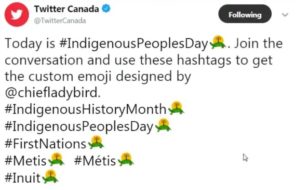
A special edition Turtle Island emoji can be activated on Twitter by using certain hashtags during the month of June.
The emoji, designed by Anishinaabe artist Nancy King who goes by the name Chief Lady Bird, was created in honour of Indigenous History Month.
Twitter reached out to Chief Lady Bird in May about the project.

“I guess they had been thinking about how the emoji could be done in a good way and who should be the one to create that imagery,” she said.
“They didn’t want to have their team do it because they didn’t want to appropriate.”
Chief Lady Bird, who is from Rama First Nation and Moosedeer Point First Nation, uses street art, community-based murals and digital illustration to challenge the lens through which Indigenous people are often viewed.
Votes for Turtle Island
“The emoji designed by Chief Lady Bird and related hashtags recognize and celebrate powerful Indigenous voices and movements on Twitter,” said Jennifer Hollett, Head of News, Twitter Canada via an email statement.
“Indigenous History Month is an opportunity to follow more Indigenous conversations on Twitter and see the rich diversity of history, stories, and culture, as well pressing issues the communities are facing.”

She said the project presented a challenge as Indigenous Peoples and cultures in Canada vary greatly so finding one symbol to represent them all wasn’t something she wanted to decide on her own.
“I figured why even attempt it myself when I could consult with my community, bringing it to the people, because that’s who the emoji is for,” she said.
She took to the social media outlet with a poll to get an idea of what kind of symbols Indigenous people were wanting to see.
The Turtle Island image took 50 per cent of the votes, winning over an eagle feather (30 per cent), smudge bowl (14 per cent) and a strawberry (6 per cent).
“I was glad that Turtle Island was the one that was picked because this is the land that we’re all standing on right and that’s what unifies us to call this continent Turtle Island,” she said.
Turtle Island is the central part of a creation story that talks about how much people have been given in order to survive, and the story also describes a reciprocal relationship that needs to be honoured.
“To think about the land as a turtle acknowledges all of that but also it reminds us of our responsibilities to the Earth,” she said.
The other challenge was working on a much smaller scale than her work is usually presented in, often building-sized murals.
The emoji is available on Twitter for the month of June when users tweet using the hashtags #IndigenousHistoryMonth #IndigenousPeoplesDay #FirstNations #Metis #Métis or #Inuit.
The Turtle Island image will disappear in July but Chief Lady Bird hopes that next year Twitter Canada will consult with another Indigenous artist from another nation in order to further representation of different communities.


